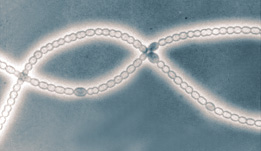N. punctiforme strain ATCC 29133 (deposited in the ATCC from the original PCC 73102 culture) has a complex life cycle in the differentiation of heterocysts, hormogonia and akinetes. The vegetative cells are 5 to 6 m m in diameter, hormogonium cells 1.5 to 2 m m, heterocysts 6 to 10 m m and akinetes 10 to 20 m m. The strain was isolated from symbiotic association with the gymnosperm cycad Macrozamia sp. (Rippka and Herdman, 1992). In the laboratory, N. punctiforme 29133 will reconstitute an extracellular symbiotic association with the bryophyte hornwort Anthoceros punctatus and an intracellular association with the herbaceous angiosperm Gunnera spp. (Meeks, 1998). As one of a small subset of cyanobacteria, N. punctiforme grows rapidly under completely dark heterotrophic conditions, with sucrose, glucose or fructose as the carbon source (Rippka and Herdman, 1992). In addition to its symbiotic and heterotrophic competence, N. punctiforme is amenable genetic analysis and replicates, or recombines into its chromosome, exogenous DNA following electroporation or conjugation with Escherichia coli as a donor. Cells can be mutagenized by chemical agents, exogenously supplied transposons, or by targeted gene replacement and the mutant phenotypes complemented by the wild-type gene replicated in trans in a shuttle plasmid (Cohen et al., 1998). The N. punctiforme genome, at approximately 7.54 Mb with a 45.2 mol % GC, is amongst the largest of all cyanobacteria (Rippka and Herdman, 1992), is significantly larger than any other cyanobacterium that has been sequenced and is the largest microbial genome sequenced thus far by the JGI. Sequence analysis of N. punctiforme is likely to yield unique information on global regulation of multiple developmental pathways, symbiotic association, regulation of carbon and nitrogen fixation, and phylogenetic relations amongst the cyanobacteria, the most ancient lineage of oxygen-producing photosynthetic organisms on earth. References: Castenholz, R.W. and J.B. Waterbury. 1989. Oxygenic photosynthetic bacteria. Group I. Cyanobacteria. In: Bergey’s Manual of Systematic Bacteriology, vol. 3, pp. 1710-1789, J.T. Staley, M.P. Bryant, N. Pfenning and J.G. Holt (eds.), Williams and Wilkins, Baltimore. Cohen, M.F., J.C. Meeks, Y.A. Cai and C.P. Wolk. 1998. Transposon mutagenesis of heterocyst-forming filamentous cyanobacteria. Methods Enzymol. 297:1-17. Dodds, W.K., D.A. Gudder and D. Mollenhauer. 1995. The ecology of Nostoc. J. Phycol. 31:2-18. Meeks, J.C. 1998. Symbiosis between nitrogen-fixing cyanobacteria and plants. BioScience 48:266-276. Potts, M. 2000. Nostoc. In: The Ecology of Cyanobacteria: Their Success in Time and Space. Kluwer Academic Publishers, in press. Rippka, R. and M. Herdman. 1992. Pasteur Culture Collection of Cyanobacterial Strains in Axenic Culture, Catalogue and Taxonomic Handbook. 103 pp. Institut Pasteur, Paris. Nostoc
punctiforme (Munich University) |
||
|
||
Nostoc punctiforme ATCC 29133

